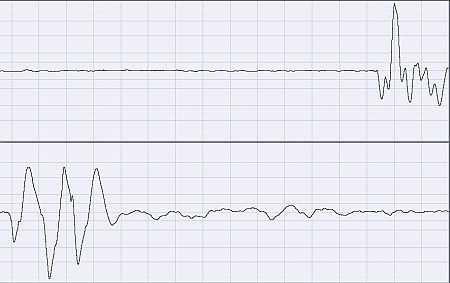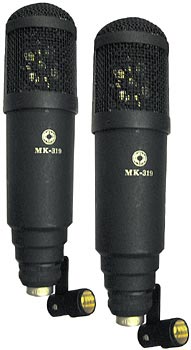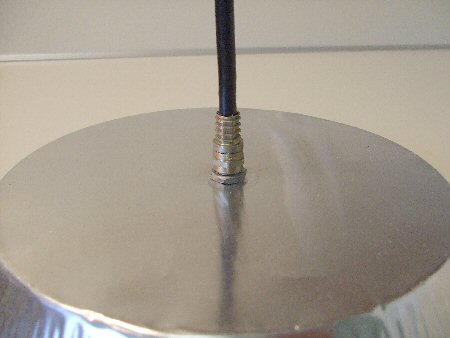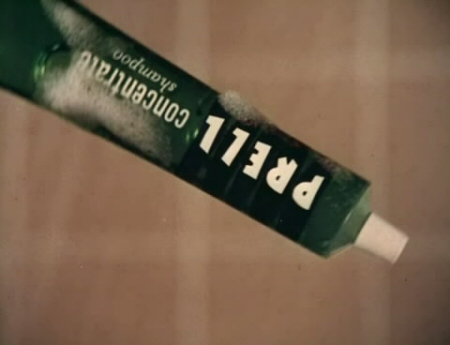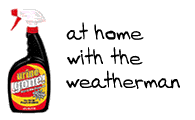Direct mp3 download or play: New Year’s 2013
I made this recording using the same setup as in “4th of July Ambience 2012,” but used Audacity (free sound recording software) instead of VSTHost. The recording starts at around 11:55 PM, December 31st, 2012 and ends at about 12:15 AM, January 1st, 2013. I think the sound is louder and has more bass compared to last year. There is more “hiss” or white noise this time, probably due to microphone gain being somewhat too high. Then I put the recorded file into Adobe Audition, slightly amplified the audio, and put five second fades at the beginning and end. The mp3 here is 320 kilobits per second and 48 kilohertz, the highest possible quality. This is the first audio file I’ve done this way. Let me know if you have trouble playing this one.
It does seem that New Year’s is a lot like the 4th of July as far as the kind of sounds I hear. I didn’t notice any yelling of “Happy New Year” or banging pots and pans (well, maybe very faintly in the distance) as I have in the past. This post likely has typos, but I wanted to get this up and running right away. In the coming days, I’ll be attempting to correct mistakes. I know that sounds dumb, but that’s what I’m all about. Happy Fiscal Cliff… I mean New Year.

New Year’s 2013
4th of July Ambience 2012
Direct mp3 download or play: 4th of July Ambience 2012
This is similar to “4th of July Ambience 2011,” but it is probably the longest of any of my 4th of July recordings. I know it may be boring, and I won’t be upset if you don’t listen to all of it. Below are pictures of how I made this recording.
 Audio Technica AT825 Stereo Microphone
Audio Technica AT825 Stereo Microphone
Alesis NanoCompressor
Recording Setup in VST Host
 Waveform information from Adobe Audition after slightly changing levels. (Note peaks at -.3 DB each side and no clipping)
Waveform information from Adobe Audition after slightly changing levels. (Note peaks at -.3 DB each side and no clipping)
 Waveform of entire recording after slightly changing levels. (Refers to current amplitude statistics)
Waveform of entire recording after slightly changing levels. (Refers to current amplitude statistics)
4th of July Ambience 2010
Direct mp3 download or play: 4th of July Ambience 2010
Once again, I apologize for being dumb enough to not notice this post was accidentally deleted. Please leave comments. I discovered this when I started preparing “4th of July Ambience 2012.” I hope to have that up in a week or so. You may have thought “This time that Weatherman is gone for good.” I guess I may be suffering from a little “2012 Madness.” Please be patient, I may be making a comeback!
I’ve been quite lazy the last month, but I’m still around, and now I have for you the sounds of the Fourth of July. This was recorded from about 9:45 PM to 10:45 PM on July 4th, 2010. I used my inexpensive electret condenser microphones installed on the outside of my house. They are separated by approximately 30 feet. The live sound was processed though through an audio mixer with some additional electronics and I explain in detail and show pictures here and here.
Also, for about a month or so, I’ve been learning how to use VST (Virtual Studio Technology) plugins with Adobe Audition. First of all, I didn’t realize how much of this software is free online and second, a lot of the plugins work quite well, even on my older Pentium 4, single core computer. And third, here is the part I like best. I’ve discovered that VST plugins can be used in real time with Winamp and Media Player Classic.
Now for this recording of July 4th, I decided to process the sound with a VST plugin compatible with Adobe Audition called “Broadcast.” Basically it is a three band software compressor and it is free online. I think it worked well to tame the sharp peaks of the exploding fireworks. However something unexpected happened. Recording explosions is difficult. If the recording level is too high, distortion and clipping can happen, and if the level is too low, the soft ambience is lost. Unfortunately, this recording has some clipping and it appears to be analog, and “clip restore” in Adobe Audition won’t touch it. I suspect the clipping was coming from the “Feedback Destroyer” box set up to operate as a parametric equalizer. When I applied the “Broadcast” VST effect to the recording it not only smoothed out the sound and didn’t allow any peaks to exceed -.4 db (the level I set on the plugin), but it seemed to repair the clipped audio as well. I have pictures showing the waveform. I don’t really understand what is happening as I have a lot more to learn.

Here is very small portion of clipped audio in Adobe Audition of exploding fireworks. Notice the clipping (flat parts of the waveform, bottom left) is happening below the maximum digital level.
This shot shows the same audio after applying the “Broadcast” VST plugin.
Left side microphone
Right side microphone (with tissue paper windscreen removed)
New Year’s 2012
Direct mp3 download or play: New Year’s 2012
 VST Capture Setup (click picture for high resolution view)
VST Capture Setup (click picture for high resolution view)
Here is my recording of New Year’s 2012. Recording time was from 11:53 PM, 2011 to about 12:21 AM, 2012. This was made using the same equipment as in “Springtime Ambience 2010 (updated)” and “Ambience Recording.” I used a free VST plugin called “Broadcast” which seems to work very well at preventing digital clipping. However, there is quite a bit of white noise due to the inexpensive electret condenser microphones, and the large amount of gain in the VST processing. I can assure you there is no digital clipping distortion on the recording.
Waveform for sound at approximately -24:44 on the counter (click picture for high resolution view)
This view of the initial attack of a loud explosion shows some flattening of the waveform. The sound doesn’t seem to have audible clipping distortion, but I think it is actually analog clipping occurring in the microphone preamplifier. This kind of distortion is generally considered less objectionable. I think when listening carefully, some of this effect can be heard as a slightly higher pitched “crack” at the beginning of some of the explosions. As I said before there is no digital distortion and the peak level throughout is no higher than -.37 db.
I almost forgot… Happy New Year!
Springtime Ambience 2010 (updated)
Direct mp3 download or play: Springtime Ambience 2010
Here is a new recording I made using microphones installed on the outside of my house. You can go here to see pictures of the microphones I’m using, and by the way, these still the original mikes. They have endured cold, moisture, squirrels, and birds pecking at them and they still work quite well.
Shown here are Countryman Type 85 direct boxes, an electret condenser microphone phantom power inserter box (middle and behind direct boxes), and a Mackie 1202VLZ mixer. The two brown cables are the balanced audio coming from the direct boxes connected to channels 1 and 2 on the mixer. The mixer provides 48 volts of regular phantom power to the direct boxes.
Below the direct boxes, electret phantom power inserter and mixer is a DBX 166A compressor and a Behringer Feedback Destroyer Pro DSP1100P. I explain how all of this works here. This is how I can make really inexpensive microphones sound reasonably good. Imagine putting Neumann U87’s out in the rain, just to get an ambient recording. As far as I know they are the finest microphones made (over $2,000 each) and they would be ruined. With my arrangement, I get good results (I understand that is a matter of opinion and there is really no comparison between good studio microphones and the mikes I am using) and if a microphone fails I can just get another one for less than three dollars from Radio Shack.
This is another post that was deleted by mistake. Sorry, I lost the comments.
4th of July Ambience 2011
Direct mp3 download or play: 4th of July Ambience 2011
This time around, I kept it simple by using my Oktava MK-319 condenser microphones. One was placed outside my front living room window facing west, and the other on my back deck facing east. The microphones were connected through my Yamaha model MG10/2 mixer and then to the computer. I recorded using VST Host and I used one VST plugin called Barricade (a brick wall limiter). I kept the microphone gain controls on the mixer on the low side which preserved dynamics, and the limiter did not need to reduce the gain that often. After that, I checked the recording waveform in Adobe Audition and I boosted the lows (below 100 hertz) by about 6db. I felt that was necessary because I had the low cut filter switched on at the microphones and on the mixer. The low cut was on because these mikes are very sensitive to wind noise. I think I overdid it though, because the the very low frequencies of the exploding fireworks put on by the city of Seattle really weren’t audible on the recording. Finally, I converted the file to MP3 using Razorlame and the lame encoder. The file is 192 KBPS stereo and48 KHZ sampling rate. I’m not sure if 48 KHZ is a problem , but it is supposed to be better than 44.1 KHZ. Most MP3s are at 44.1. Let me know if it’s a problem and I’ll change this to 44.1. Enjoy!
Oktava MK-319 Condeser Microphones
Bicycle Horn Under Water 2011
Direct mp4 file download or play: Bicycle Horn Under Water 2011
Here I am back again! For the last few months I’ve been quite lazy and uninspired, but I’ve been on my YouTube (a54dumb) page periodically. This video is similar to “Bicycle Horn Under Water ’09” except that I had no help and I placed a microphone directly in the water. I covered the microphone with plastic wrap before submerging it into the glass bowl filled with water. The plastic wrap was sealed using a rubber band, and I used tweezers to hold the microphone in place. Hopefully this will provide for a few chuckles and inspire me to be here more often.
New Year’s 2011
Direct mp3 download or play: New Year’s 2011
I started recording about 11:59 PM, December 31st, 2010 and stopped just before 12:20 AM on January 1st, 2011, using only my Sony PCM-D50 digital recorder. The recorder was on a tripod facing out of the sliding glass door which opens out to my deck. I kept the door open during the recording and with the outside temperature possibly below 25 degrees Fahrenheit, the cold air rushing in caused a lot of creaking as the furniture and other items inside my living room began to make contact with the cold air. The occasional snapping and popping noises are sounds that the table and chairs made as cold air rushed into the room. I believe the door frame made some noises, as well.
The Pineapple Express of 12-12-2010
Direct mp3 download or play: The Pineapple Express of 12-12-2010
Heavy rain falling on the bamboo behind my house.
Direct mp3 download or play: Less Rain, More Wind
Less Rain, More Wind
This is some the sound of steady, heavy rain which fell late on December 11th through the middle of December 12th 2010. In a little more than 12 hours, I received three-and-two-thirds inches of rain, and some areas around Seattle received over 10 inches. As you can see on a National Weather Service water vapor satellite picture I included, a stream of white appears to come up from the Hawaiian Islands and head straight for the Pacific Northwest, bypassing California completely. This condition is known as a “Hawaiian” storm, but more recently it goes by the more colorful name “Pineapple Express.” I guess the idea of where pineapples are grown makes this name more dramatic and exciting. To learn more go here.
Since I recently had my house painted, the outside microphones were removed. I simply placed the same microphones in windows about twenty feet apart. More information about how I made this and other recordings of this kind, check out my other posts here.

U. S. National Weather Service water vapor satellite picture, Dec. 12, 2010, 5 AM Pacific Standard Time.
El Niño 1997-98 Martinez, CA
Direct mp3 download or play: Part 1
Part 1
Direct mp3 download or play: Part 2
Part 2
Direct mp3 download or play: Part 3
Part 3 With Effects
During the fall and winter of 1997 and 1998, I made several recordings of falling rain at my home in Martinez, California. The rain was some the most intense I had ever witnessed. California was in the midst of an El Niño.
These were made using a DAT recorder, and with a similar setup to recordings I’ve made more recently in Seattle. The main difference, however, is the distance between the two microphones was much greater (over 100 feet). One of the microphones was mounted on an aluminum pie pan, which I hung in a bush on the hillside behind my house, and the other microphone was mounted under the eaves of my house near a downspout.
I used RG-59 cable TV wire, complete with fittings for the more than 100 foot run from the pie pan microphone to my mixer. Because of my job as a cable TV technician, I had access to this type of wire and it worked quite well for audio.
The recordings are quite long and probably somewhat boring unless you really like ambience. In addition, my recording technique uses lots of compression, and tends to show itself with a lot of white noise coming up at times. The audio level noticeably increases and decreases on quieter parts and louder parts, respectively. With that in mind, I hope you can imagine what a really wet day in California can be like.

Electret condenser microphone mounted on pie pan
Pie pan and microphone hanging
Backside showing “F” fitting
The Laugh Box
Here is a recording I made sometime between 2000 and 2002. It’s a box that plays an actual tiny vinyl record of laughter. My parents probably bought it in the early 1970s. I remember using the same microphone that I used for recording my stomach noises. It was connected directly to the microphone input of my Hewlett-Packard Pavilion PC. While recording the laugh box, it was beginning to malfunction and finally stopped.
New Year’s 2010
Direct mp3 download or play: New Year’s 2010
Here is the audio from my outside microphones for New Year’s 2010. I started recording at 11:51 PM on December 31, 2009, and stopped recording at 12:30 AM on January 1, 2010.

This is the microphone for the left side. Note the foil taped to the cable in an effort to keep birds away.
This is the microphone for the right side. I had to remove the tissue paper being used to reduce wind noise because birds kept pecking at it. In addition, the cable running to this microphone was damaged by a squirrel and it is more than 15 feet shorter. The microphone still works quite well.
4th of July Ambience 2009
Direct mp3 download or play: 4th of July Ambience 2009
This was recorded with same setup as in 2008, except the sound was recorded onto my Sony PCM-D50 digital recorder. In addition, here is the first 4th of July recording from my backyard in Seattle. This was the last recording I made on this setup before a squirrel chewed through one of the cables leading to a microphone. See more about it here.
Thunder June 21, 2009
Direct mp3 download or play: Thunder June 21, 2009
Here is a little thunder I recorded on Sunday afternoon June 21, 2009. The first rumble was the loudest, and in spite of the record level on my Sony PCM-D50 being around the mid point (5 or 6), clipping was indicated when I transferred the file to Adobe Audition. I used “clip restore” to fix the distortion, which incidentally I couldn’t hear anyway. I know this thunder isn’t much compared to storms in the Midwest, but I thought it had kind of a nice ambience along with the other sounds around my house in Seattle. I’ve included a few photos of the sky conditions around the time of this recording as well.



A bit out of focus, maybe.
My Prell Concentrate

I guess this is sort of a tribute to my favorite brand of shampoo. In particular there is a recording I made from the late 1970s or early 1980s featuring me making noises with a tube (or bottle as I prefer to call it) of Prell Concentrate.
Superscope C-104 cassette recorder used to record my Prell Concetrate bottle.
Sony F-98 dynamic microphone used for Prell Concentrate.
Prell Concentrate sponsors The Doris Day Show!
Bicycle Horn Under Water 2009
Direct mp4 file download or play: Bicycle Horn Under Water ’09
New Version Today: Sharper, Brighter, Dumber!
The last time I did this was in 1973 when I was nineteen years old. This time was more high tech. I connected a Sony Handycam to an Apple MacBook laptop computer using a firewire cable. I captured video from the Handycam and from the camera built into the laptop. The audio features the microphone in the laptop as well as from the camera. Also there was no tape in the Handycam and all of the video and audio was captured directly to the hard drive on the laptop computer. Then the video was edited on Ulead VideoStudio 9, and the audio on Adobe Audition 2.0. I think I did quite a dumb editing job. Hopefully you will have a good laugh. Check out the original “Bicycle Horn Under Water” and you should notice the similarity in sound quality.
New Year’s Seattle 2009
Direct mp3 download or play: New Year’s Seattle 2009
Here is an uncut recording of New Year’s 2009 starting from just before 11:49 PM December 31st, 2008 and ending at 12:15 AM on January 1st, 2009. I’m using my outside microphones and a shortwave radio receiver. The sound is similar to “4th of July Ambience 2008” and “Ambience Recording” with the addition of the shortwave radio station WWV running simultaneously.
The Rototiller Tape
Direct mp3 download or play: The Rototiller Tape
 Me and my grandfather’s rototiller in 1958
Me and my grandfather’s rototiller in 1958
 Another shot of me and the rototiller
Another shot of me and the rototiller
Here is a recording I made in the 1980s, which was played several times on Over the Edge and in particular an episode called “The Starting Line.” I would usually announce that while I was recording, the rototiller would hit a rock and the person operating it would cuss. That never actually happened. With that in mind, this “field” recording seems to be well liked. As a matter of fact, it is a field recording and of course I used my Sony TC-D5M cassette recorder with a one point stereo condenser microphone. I have for you the entire “Rototiller Tape,” plus a couple of pictures of myself and a rototiller at my grandparent’s home in Santa Rosa, California, most likely in 1958.
Recent Posts
- Buddy Is Bored
- Pencil Man
- My Stomach 2022
- 4th of July Ambience 2021
- Richard Lyons, Avery Mann & girlfriend, and Myself at Snoqualmie Falls, Washington in 2005
- New Year’s 2021
- Dirty Booper
- Lady Seiko Watch Commercial
- 4th of July Ambience 2020
- The Stupid “T” Horn
Categories
- 16 Millimeter Films
- Answering Machine Recordings/Ringtones
- Baby Room Monitors
- Booper
- Cats and Bees
- Cleaners and Cleaning Supplies
- Family Tapes
- Ham Radio Jammers
- Microphone Tests
- Music I Listen To
- My Vintage Equipment
- Open Reel Tapes
- Outside Microphone & Field Recordings
- Pictures & Drawings
- Random Audio & Video
- Street Names Update
- Uncategorized
- Weather
| M | T | W | T | F | S | S |
|---|---|---|---|---|---|---|
| « Jul | ||||||
| 1 | 2 | |||||
| 3 | 4 | 5 | 6 | 7 | 8 | 9 |
| 10 | 11 | 12 | 13 | 14 | 15 | 16 |
| 17 | 18 | 19 | 20 | 21 | 22 | 23 |
| 24 | 25 | 26 | 27 | 28 | 29 | 30 |



